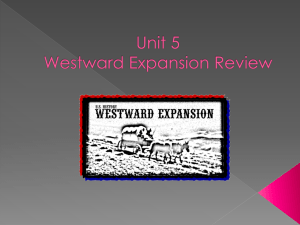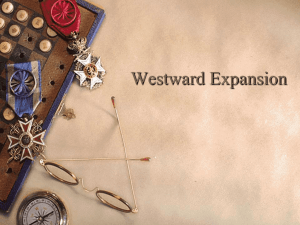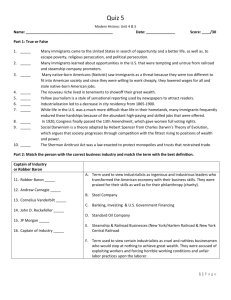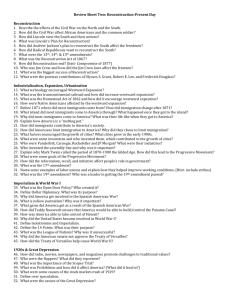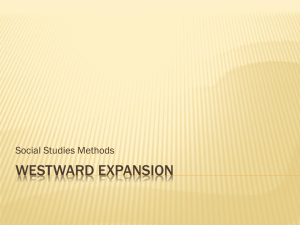Study
advertisement
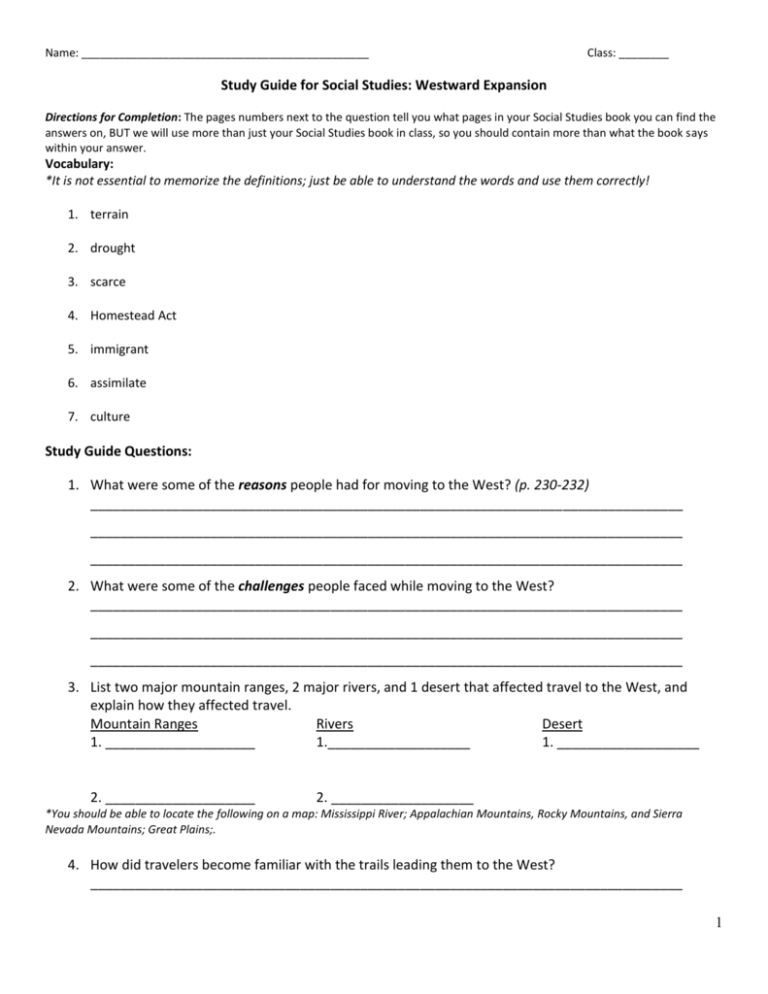
Name: ______________________________________________ Class: ________ Study Guide for Social Studies: Westward Expansion Directions for Completion: The pages numbers next to the question tell you what pages in your Social Studies book you can find the answers on, BUT we will use more than just your Social Studies book in class, so you should contain more than what the book says within your answer. Vocabulary: *It is not essential to memorize the definitions; just be able to understand the words and use them correctly! 1. terrain 2. drought 3. scarce 4. Homestead Act 5. immigrant 6. assimilate 7. culture Study Guide Questions: 1. What were some of the reasons people had for moving to the West? (p. 230-232) _______________________________________________________________________________ _______________________________________________________________________________ _______________________________________________________________________________ 2. What were some of the challenges people faced while moving to the West? _______________________________________________________________________________ _______________________________________________________________________________ _______________________________________________________________________________ 3. List two major mountain ranges, 2 major rivers, and 1 desert that affected travel to the West, and explain how they affected travel. Mountain Ranges Rivers Desert 1. ____________________ 1.___________________ 1. ___________________ 2. ____________________ 2. ___________________ *You should be able to locate the following on a map: Mississippi River; Appalachian Mountains, Rocky Mountains, and Sierra Nevada Mountains; Great Plains;. 4. How did travelers become familiar with the trails leading them to the West? _______________________________________________________________________________ 1 _______________________________________________________________________________ _______________________________________________________________________________ 5. What were some of the challenges people faced while living in the West? _______________________________________________________________________________ _______________________________________________________________________________ ______________________________________________________________________________ 6. How did people moving to and living in the West affect the environment? _______________________________________________________________________________ _______________________________________________________________________________ _______________________________________________________________________________ 7. How did the mining industry relate the boom-bust (ghost town) cycle of towns in the West? _______________________________________________________________________________ _______________________________________________________________________________ ______________________________________________________________________________ 8. How did the invention of new technologies affect people in the West? _______________________________________________________________________________ _______________________________________________________________________________ 9. How did railroads affect the following things? (p. 223-227) Travel- Trade- Environment- 10. Explain the role of the following groups of people during Westward Expansion: a. Miners b. Immigrants (Chinese and European) c. Farmers/Homesteaders 2 d. Mexican Americans e. Ranchers/Cowboys f. African Americans 11. During the Westward Expansion, there were conflicts between different groups of people. Some were resolved and some were not. Tell how the following groups interacted with each other in a negative way. (p. 226-227, 241, 246-249) a. Cowboys vs. Homesteaders b. Homesteaders vs. Native Americans c. Ranchers vs. Native Americans d. American Miners vs. European/Asian Immigrants 12. How did Westward Expansion affect Native Americans? Include the varying opinions about land ownership. (p. 246-249) What were the Federal policies that affected Native Americans? 13. One railroad company ______________________________ began constructing a railroad in Omaha, Nebraska and built West. The company hired several workers including many immigrants from _____________________. 14. Another railroad company called ________________________________ began construsting a railroad starting in Sacramento, California and built East. The company hired several workers including many immigrants from _______________________. 15. The Union Pacific and Central Pacific met in _________________________________, Utah where they hammered in a gold spike to celebrate! *Can you recall the 13th, 14th, and 15th amendment? They may show up on your test on THURSDAY! 3 Name: ___ANSWER KEY___________________________________________ Class: ______ Study Guide for Social Studies: Westward Expansion Directions for Completion: The questions below are directly related to the 5th Grade Social Studies standards and will help you prepare for your tests and quizzes in this unit. As we study each topic, you can fill in the answers to the question. The pages numbers next to the question tell you what pages in your Social Studies book you can find the answers on, BUT we will use more than just your Social Studies book in class, so you should contain more than what the book says within your answer. SC State Social Studies Standards: 5-2.1 Analyze the geographic and economic factors that influenced westward expansion and the ways that these factors affected travel and settlement, including physical features of the land; the climate and natural resources; and land ownership and other economic opportunities. 5-2.2 Summarize how technologies such as railroads, the steel plow and barbed wire, federal policies such as subsidies for the railroads and the Homestead Act, and access to natural resources affected the development of the West. 5-2.3 Identify examples of conflict and cooperation between occupational and ethnic groups in the West, including miners, farmers, ranchers, cowboys, Mexican and African Americans, and European and Asian immigrants. 5-2.4 Explain the social and economic effects of westward expansion on Native Americans, including opposing views on land ownership, Native American displacement, the impact of the railroad on the culture of the Plains Indians, armed conflict, and changes in federal policy. Vocabulary: *It is not essential to memorize the definitions; just be able to understand the words and use them correctly! 1. climate – the average weather of a region 2. terrain – land features 3. drought – an extended period of no rain 4. scarce – insufficient to satisfy needs; not easily available 5. mechanical reaper – an invention of the 1830s that helped farmers harvest their crops more quickly 6. steel plow -- the 1837 invention of John Deere that helped farmers turn over their difficult land more easily 7. subsidy – extra money provided by the government or another organization to help 8. Homestead Act – the Act Congress passed in 1862 that gave citizens and immigrants 160 acres of land if they paid a small amount and stayed on the land to farm for a minimum of 5 years 9. industry – a business activity, usually characterized by trade, manufacturing, and technologies 10. conflict – a problem. It can be internal, meaning in someone’s mind, or external, between man vs. nature, man vs. man, or man vs. animal. 11. ethnic group – a group of people who share the same culture 12. immigrant – a person who moves into a country from another country 13. displacement -- being forced to move from your home 14. assimilate -- becoming “like” those around you 4 15. culture – the behaviors and beliefs of a particular ethnic group Study Guide Questions: 1. What were some of the reasons people had for moving to the West? (p. 230-232) Gold Rush, mining for mineral resources, cheap land provided by the Homestead Act, chance for more freedom for African Americans 2. What were some of the challenges people faced while moving to the West? Crossing rivers and mountains, impassable trails, lack of water, extreme heat or cold 3. List two major mountain ranges, 2 major rivers, and 1 desert that affected travel to the West, and explain how they affected travel. Mountain Ranges 1. Rocky Mountains – difficult to cross because of the steep and rocky terrain 2. Sierra Nevada Mountains -- difficult to cross because of the steep and rocky terrain Rivers 1. Columbia River – difficult to cross 2. Colorado River -- difficult to cross Desert Painted Desert – very little water, extreme temperatures (cold at night, hot during the day) *You should be able to locate the following on a map: Mississippi, Columbia, Colorado, and Snake Rivers; Appalachian, Rocky, and Sierra Nevada Mountains; Painted Desert; Great Plains; and St. Louis. 4. How did travelers become familiar with the trails leading them to the West? Many of the trails were old Native American trails that had been traveled and mapped by mountain men and explorers. As time passed, the trails became more traveled and easier to follow. 5. What were some of the challenges people faced while living in the West? Building sod houses because of no trees, new tools to plow through tough soil, figuring out irrigation due to dry climate, hot, dry summers, drought, dust storms, insect swarms, snow in winter, Spring floods, storms, tornadoes, unpredictable weather 6. How did people moving to and living in the West affect the environment? Pollution from mining and new railroads, destruction of the buffalo, overfarming and overgrazing of the soil 7. How did the mining industry affect the boom-bust cycle of towns in the West? A mining company would start mining, which would draw people coming for jobs. A city would sprout up, called a “boom town.” Once the resources were depleted, people would leave the town, creating a “ghost town.” 5 8. How did the invention of new technologies affect people in the West? Steel plow – helped farmers plow up difficult sod Mechanical reaper – helped farmers harvest their crops and produce more Telegraph – helped people communicate faster Transcontinental Railroad (see question #10) Barbed wire- wire fencing made with barbs twisted every few inches to keep livestock from roaming 9. What was the effect of Westward Expansion on Mexican Americans? Many of the Mexican landowners lost their lands in Texas (which used to be a part of Mexico), as settlers came through and claimed land for ranching or farming. 10. How did railroads affect the following things? (p. 223-227) TravelMade travel faster and easier TradeMade trade faster and easier, ranchers could get their cattle to the east to sell more quickly Raw materials were shipped east to manufacturing plants; livestock were shipped east to meat packing plants EnvironmentPolluted the environment, destruction of buffalo, use of coal to run the RR engines led to more mining 11. Explain the role of the following groups of people during Westward Expansion: a. Miners – first group to move West, initially in search of Gold, and then to work for companies that were mining other resources b. Immigrants (Chinese and European) – Irish Immigrants helped to build the Transcontinental railroad from the East, Chinese Immigrants helped to built the Transcontinetnal railroad from the West, other European immigrants settled land in the West c. Farmers/Homesteaders – began settling and farming the land of the West d. Mexican Americans – got lands taken away from them, vaqueros helped teach the American cowboys how to herd cattle e. Ranchers/Cowboys -- ranchers settled the land of the West, raising cows and other animals. Cowboys helped to “drive” these animals to the railheads, where the animals were shipped back East to market. f. African Americans -- had a variety of roles. Became Homesteaders and cowboys, as well as “Buffalo Soldiers,” who helped to “police” the West, including driving Native Americans into reservations. 6 12. During the Westward Expansion, there were conflicts between different groups of people. Some were resolved and some were not. Tell how the following groups interacted with each other in a negative way. (p. 226-227, 241, 246-249) a. Cowboys vs. Homesteaders Ranchers tromped over the farms of the homesteaders with their cattle, so the homesteaders started putting up barbed wire to keep ranchers and their cattle out of the farms. b. Homesteaders vs. Native Americans The homesteaders set up their farms on land belonging to the Native Americans, so many conflicts arose between the two groups. c. Ranchers vs. Native Americans The ranchers tromped through the land belonging to the Native Americans, so many conflicts arose between the two groups. Ranchers also helped eliminate the buffalo population, which Native Americans used as a food source. d. American Miners vs. European/Asian Immigrants Miners from the U.S. didn’t like the immigrants “taking their jobs,” and immigrants didn’t like that the U.S. miners were being paid more. 13. How did Westward Expansion affect Native Americans? Include the varying opinions about land ownership. What were the Federal policies that affected Native Americans? (p. 246-249) Dawes Act: made American Indians farmers, which split up reservation land. Other Laws: made Native American religious practices (like the Ghost Dance) illegal Many Native Americans were forced to move onto small reservations when they were kicked out of their homeland. Laws made their religious practices illegal and took away their land. They lost their homeland and their way of life. Native Americans had a different idea of land ownership than whites. They believed that the land belonged to the group, not individuals. This policy violated those beliefs and the traditions of hunting that had sustained Native American culture for centuries. 7

